By Harold Ford
“The problem of the Twentieth Century is the problem of the colour-line.”
–from Address to the Nations of the World, W. E. B. DuBois, July 1900
“As much as we all try to think we have all reached the promised land, the reality is there’s still alot of separation.” –Bob Campbell, Motown Man author, Dec. 11, 2020
Flint author Bob Campbell’s first book, Motown Man, was virtually launched Dec. 11 via Zoom and Facebook in an event sponsored by the Flint Festival of Writers. Katie Curnow, a Flint Festival board member, hosted the event. Jan Worth-Nelson, East Village Magazine consulting editor, moderated the discussion.

Author Bob Campbell
(Photo source: Goodreads website)
Motown Man follows the main character, Bradley Cunningham, for five hellishly cold days in the Flint area during a November in the 1990s. “A cold wind swept down out of Canada” and enveloped Cunningham and his fiancée, Abigail Larsen, in events that would have profound and lasting impact on their future.
Bradley is Motown Man, a moniker bestowed on him by his brother James — not Gospel Man, nor Rapper Man, he points out — rather “an agreeable and likable kind of brotha…you’re like Motown music for all these white folks.”
Flint and Anytown, USA
The setting should be familiar to Flintstones: “Buick City, a place where the American dream was crumbling and rusting away, a city so far removed from its glorious and arrogant past when it made America go places…his (Bradley’s) once muscular hometown was emaciating before his eyes.”
Though Campbell never specifically names the hometown of the main characters—Bradley, Abby, and James—in the book’s 200 pages, the clues are unmistakable, starting with “Buick City” and including:
–“Grand Heights”, a predominantly white suburb filled with upwardly mobiles;
— A river that divides Campbell’s fictional town, north from south;
— An “open housing ordinance that passed narrowly…in late 1960s”;
— A “planetarium…with granite monoliths”;
— A deadly Halloween prank in which young men hung a scarecrow from an expressway overpass, causing the driver to swerve and crash to her death.
Nonetheless, the decimation of the urban center depicted in Campbell’s novel could be Anytown, USA: Butler, PA; Muncie, IN; Youngstown, OH; Springfield, IL; or others. All have faded from their glory days of mid-20th century industrialization.
In fact, the high-rise structure illustrated on the cover of Motown Man is The Wick Tower, the second tallest building in Youngstown.

Wick building in Youngstown, Ohio. (Photo source Wikipedia)
Recognizable moments in the book tip the reader that Motown Man unfolds early during the decade of the 1990s, when boxer Buster Douglas springs his jaw-dropping upset of Mike Tyson (1990) and Magic Johnson shocks the world with his HIV diagnosis (1991).
Motown Man and Demolition Means Progress
Motown Man can be appropriately cast as a fictional companion to Andrew Highsmith’s scholarly work of nonfiction, Demolition Means Progress. Both are about Flint and the excruciating manifestations of the “color line.”
Demolition painfully reminds readers that: “By the close of the 1930s, the widespread use of restrictive covenants by local residents had helped make Flint the third most segregated city in the nation, surpassed only by Miami, Florida, and Norfolk, Virginia.”
Motown Man is the fictional descendant of Demolition set some six decades later.
In his review of Demolition, EVM writer Bob Thomas judges that, “Demolition Means Progress excels in delineating truth from fiction…”. It is arguable that Campbell’s Motown excels in extracting truth from fiction.
Many American works of fiction and nonfiction—including Demolition and Motown—cry out, directly or indirectly, for resolution of America’s long racial nightmare. Will this nation ever get it right in the next 244 years of its history?The events of 2020 were not promising.
Oh, did I mention that the main characters—Bradley and Abby—comprise an interracial couple? Bradley is black; Abby is white. I’d first imagined Bradley to be white and blue collar. Instead, he was black and white collar.
Chocolate Ken, Vanilla Barbie, and the color line
Campbell’s book is an addition to the initiatives of African American men of letters—Frederick Douglass, W. E. B. DuBois, Langston Hughes, and Henry Louis Gates—that have wrestled with this nation’s “color line” in their creative works. Campbell’s contribution diverges from those of predecessors in that Motown Man is a work of fiction closer to the literary style of James Baldwin’s If Beale Street Could Talk.
Campbell told the book launch audience that Baldwin is one of his favorite writers. “I read The Fire Next Time every few years,” he said. Baldwin wrote, “Not everything that is faced can be changed; but nothing can be changed until it is faced.”
With Motown Man, Campbell tackles a variety of issues—deindustrialization, factory culture, class differences, gender issues, the ethics of journalism. And he assuredly confronts race relations.
For starters, Campbell’s fictional “chocolate Ken” and “vanilla Barbie” negotiate the sometimes uncertain waters of an intimate relationship that leads to a wedding engagement.
Bradley suffers racial indignities such as the corporate asshole who “wore black shoe polish on his face…(and) went to the Halloween party…dressed as a black hobo.”
Campbell writes,“Bradley had bitten his tongue so often it felt as though he had scar tissue for taste buds.”
Readers learn that, “The northside was another way of saying nigger, Negro, coloured, Afro-American, African-American or simply, black side of town.”
Racial stereotyping abounds and cuts in many directions in Motown Man:
— Bradley was not really a good dancer, but “in white gatherings, he noticed some folks tended to watch him like he was an NBA star playing a pick-up game at a country club.”
— A Hispanic woman informs Abby that “many non-Latinos see us and automatically think ‘foreigner’ or ‘illegal alien.’”
— An Asian-American trainer asks, “If Asian-Americans are the model mi-nor-i-tee and so damn smart, then why don’t you see us in management?”
— Abby’s father “really couldn’t understand what his daughter saw in a black man.”
— Bradley’s father, Ellis, is disapproving of his son crossing the color line: “Why does he want to hurt himself like that?”

Cover of Motown Man by Bob Campbell
(Photo source: Amazon.com)
Metaphor and simile:
Campbell’s fondness for metaphor and simile are obvious. Some examples starting with my favorite and ending with my least favorite:
— “His sometimes-fragile confidence bulked up like a boy who returned to school after summer vacation several inches taller and twenty pounds heavier.”;
— “The program’s hard copy was Bible thick”;
— “Old factory mustiness…it hung around like the ghost of greatness past”;
— “Their bodies swirled together like marble…melded black-and-white stone”;
— “Flat abs, an inviting pan of sliced, moist brownies”;
— “Head full of tiny braids that resembled a plate full of black pasta”;
— “Mr. Coffee pissed into the thermal urinal.”
I love creative metaphors and similes and I kept looking for them in Campbell’s book. I’m not sure that’s what an author wants a reader to do.
The plot thickens
About halfway through Motown Man—chapter 14 of 24—I was flush with details about location, time, and main characters; I was looking for the plot to thicken.
In the final chapters of Motown Man, I was not disappointed. The book’s climax was a gut punch.
James has the final word
Brother James may have had the final word in Campbell’s book with a soliloquy-like reflection reminiscent of the history told in Highsmith’s Demolition:
“Well, we had been bused over to a different junior high school
in a lily-white part of town. You know, for integration. And I did not
feel welcomed. Nope, I just did not feel welcomed. I did not want to
be there. Me and my boys did not want to be there. Not that things
were happening on a daily basis. I mean, there were some fights early on and a lot of talk and that sort of thing. Mostly, a lot of talk. You know, occasionally you’d see stuff like, ‘I hate niggers’ or ‘go back to Africa’ scribbled in the bathroom stalls. But we’d laugh about it, especially when you saw the word ‘nigger’ misspelled. Every now and then, you’d see the word ‘niger’ written somewhere—you know, spelled with only one g’—and I’d think, these idiots can’t even spell.”
EVM Staff Writer and Education Beat reporter Harold C. Ford can be reached at hcford1185@gmail.com.
Buying options:
Motown Man is available for purchase from the publisher, Urban Farmhouse Press.
Worth-Nelson noted the the book may be available from Book Beat, 26010 Greenfield, Oak Park, MI; online purchases are possible at Book Beat’s website.
Motown Man is available at the following Flint locations:
Totem Books, 620 W. Court St; and
Comma Bookstore and Social Hub, 132 W. 2 nd St.
Amazon.com, and Barnes and Noble also sell the book.



You must be logged in to post a comment.